Avoid losing your email account via fake "Employees Performance Report" emails
Phishing/ScamAlso Known As: "Employees Performance Report" phishing email
Get free scan and check if your device is infected.
Remove it nowTo use full-featured product, you have to purchase a license for Combo Cleaner. Seven days free trial available. Combo Cleaner is owned and operated by RCS LT, the parent company of PCRisk.com.
What kind of email is "Employees Performance Report"?
Upon inspection of the "Employees Performance Report" email, we learned that it is spam. This mail links a webpage supposedly containing a list of employees who will be terminated in the recipient's place of work. This site operates as a phishing webpage targeting email account log-in credentials.

"Employees Performance Report" email scam overview
The spam email with the subject "Monthly Employee Termination Report - Dec '23" (may vary) states that the provided link leads to the employee performance report for the previous month. The letter clarifies that names highlighted in red within the nonexistent report are of employees who will be terminated (i.e., fired/dismissed). Accessing the page will necessitate signing in by using "updated details".
As mentioned in the introduction, this email is fake, and it is in no way associated with any real individuals, companies, or other entities.
The phishing website promoted by this spam letter is presented as an email account sign-in page stating that the session has expired. Log-in credentials (i.e., passwords) entered into this site will be recorded and sent to scammers.
The theft of an email poses significant threats, particularly since these accounts are used to register other content that may also get stolen.
To expand upon the potential misuse, socially-oriented account (e.g., email, social media, social networking, etc.) owners' identities can be stolen by cyber criminals, who may then ask the contacts/friends/followers for loans or donations, promote scams, and even spread malware by sharing malicious links/files.
Hijacked finance-related accounts (e.g., online banking, money transferring, cryptowallets, etc.) can be used to make fraudulent transactions and online purchases. Should any confidential/compromising content be found on stolen data storage or similar platforms – it could be used for blackmail or other malicious purposes.
In summary, victims of spam emails like "Employees Performance Report" may experience severe privacy issues, financial losses, and even identity theft.
If you have already provided your account credentials – immediately change the passwords of all potentially exposed accounts and contact their official support.
| Name | "Employees Performance Report" phishing email |
| Threat Type | Phishing, Scam, Social Engineering, Fraud |
| Fake Claim | Email contains a link to employee performance and termination report. |
| Symptoms | Unauthorized online purchases, changed online account passwords, identity theft, illegal access of the computer. |
| Distribution methods | Deceptive emails, rogue online pop-up ads, search engine poisoning techniques, misspelled domains. |
| Damage | Loss of sensitive private information, monetary loss, identity theft. |
| Malware Removal (Windows) |
To eliminate possible malware infections, scan your computer with legitimate antivirus software. Our security researchers recommend using Combo Cleaner. Download Combo CleanerTo use full-featured product, you have to purchase a license for Combo Cleaner. 7 days free trial available. Combo Cleaner is owned and operated by RCS LT, the parent company of PCRisk.com. |
Phishing spam campaign examples
We have investigated thousands of spam emails; "Bank Confirmation", "DPD Online Confirmation Must Be Made", "UnitedHealthcare", "Amazon - Your Account Has Been Locked", and "Cashier Check" are merely some examples of ones used for phishing.
In general, spam campaigns are used to facilitate various scams and even to proliferate malicious software. The commonly held belief that spam emails are full of grammatical and spelling errors is not untrue – yet it is not exclusive. Deceptive letters can be competently made and even believably disguised as messages from genuine service providers, companies, organizations, authorities, and other entities.
How do spam campaigns infect computers?
Spam campaigns spread malware by distributing malicious files as attachments or download links. These files come in various formats, e.g., archives (ZIP, RAR, etc.), executables (.exe, .run, etc.), documents (Microsoft Office, Microsoft OneNote, PDF, etc.), JavaScript, and so on.
An infectious file starts downloading/installing malware when it is opened. Some formats can require additional user interaction to jumpstart these processes. For example, Microsoft Office files require users to enable macro commands (i.e., editing/content), while OneNote documents need them to click on embedded files or links.
How to avoid installation of malware?
Due to how widespread spam mail is and how well-crafted it can be – we strongly recommend exercising caution with incoming emails, DMs/PMs, SMSes, and other messages. Attachments or links found in dubious/irrelevant mail must not be opened, as they can be virulent. It is important to use post-2010 Microsoft Office versions since their "Protected View" mode prevents automatic macro execution.
However, malware is not distributed only via spam mail. Therefore, we also advise being careful while browsing, as fake and malicious online content usually appears legitimate and innocuous.
Furthermore, all downloads must be made from official and trustworthy channels. Another recommendation is to activate and update software using genuine functions/tools, as illegal activation tools ("cracks") and third-party updaters can contain malware.
We must emphasize that having a reputable anti-virus installed and kept updated is paramount to device/user safety. This software must be used to perform regular system scans and to remove threats and issues. If you've already opened malicious attachments, we recommend running a scan with Combo Cleaner Antivirus for Windows to automatically eliminate infiltrated malware.
Text presented in the "Employees Performance Report" spam email letter:
Subject: Monthly Employee Termination Report - Dec '23
Greetings,
Find below link to past month's employees performance report, Dec '23 :
inter-records/staff.*********/news/empl.record/2023-reports/filenumber8649968290
Note: All names highlighted in red indicate employees to be terminated.
LOGIN WITH UPDATED DETAILS TO ENABLE ACCESS
Best regards,
Director of HR
*********
Human Resource Department
*********
Screenshot of the phishing website (designed to imitate recipient's email service provider) promoted by the "Employees Performance Report" spam campaign:

Other examples of emails from "Employees Performance Report" spam campaign:
Sample 1:

Text presented within:
Subject: ******** Staffs-information/employee. 04/24/2024 08:21:36 pm
Hello everyone,
Check out last month's employee performance report (March 25) at the link below.
Interrecord/Staff.********/News/Staff Records/2023-Report/updated
Note: All names highlighted in red represents employees who will be terminated.
Screenshot of the promoted phishing site:
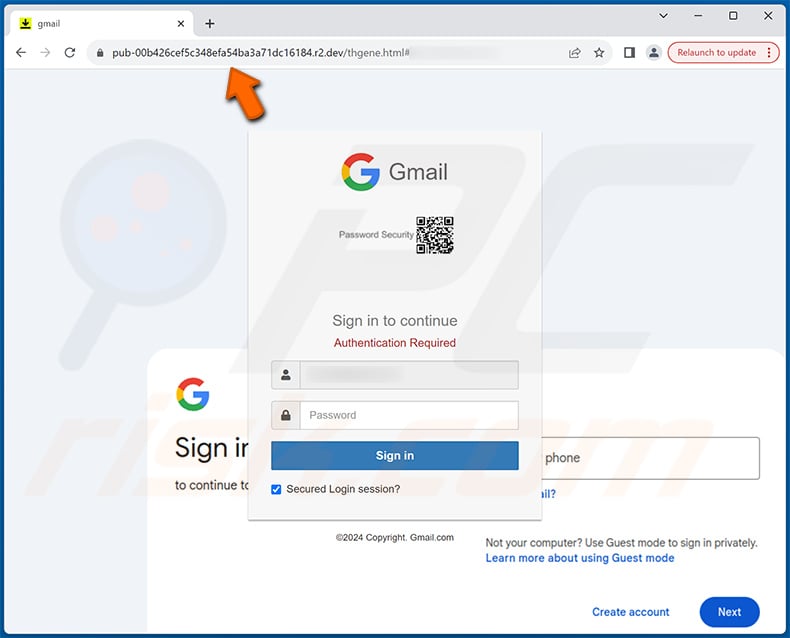
Sample 2:
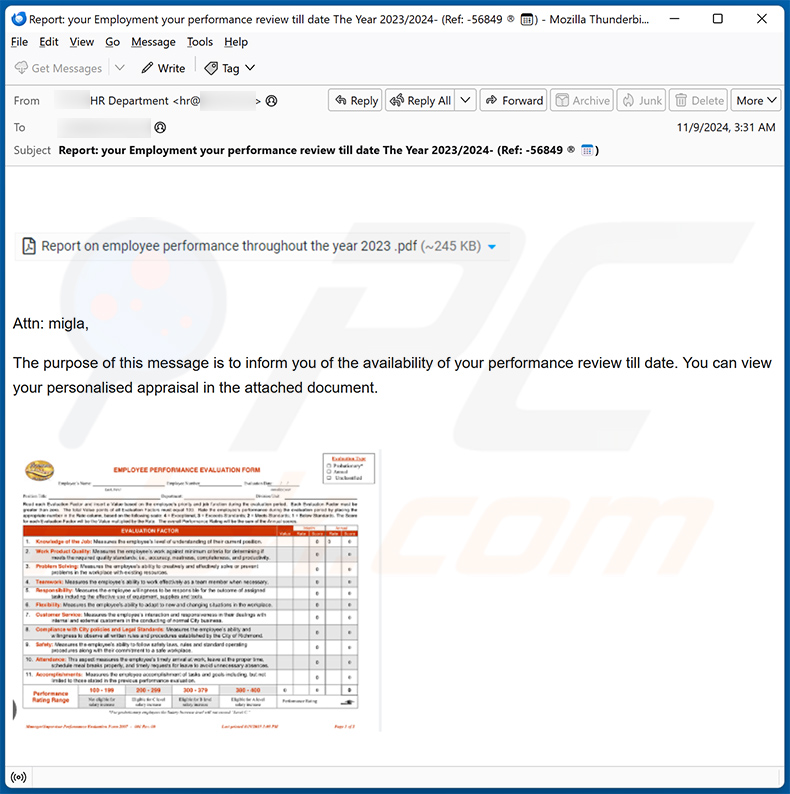
Text presented within:
Subject: Report: your Employment your performance review till date The Year 2023/2024- (Ref: -56849 ®)
Attn: -,
The purpose of this message is to inform you of the availability of your performance review till date. You can view your personalised appraisal in the attached document.
Note: All names in red are employees for whom redundancy is planned.
Our thanks and appreciation are in order for your continued contribution and commitment to our organisation.
Regards,
Director
Human Resources Department
Screenshot of the promoted phishing site:
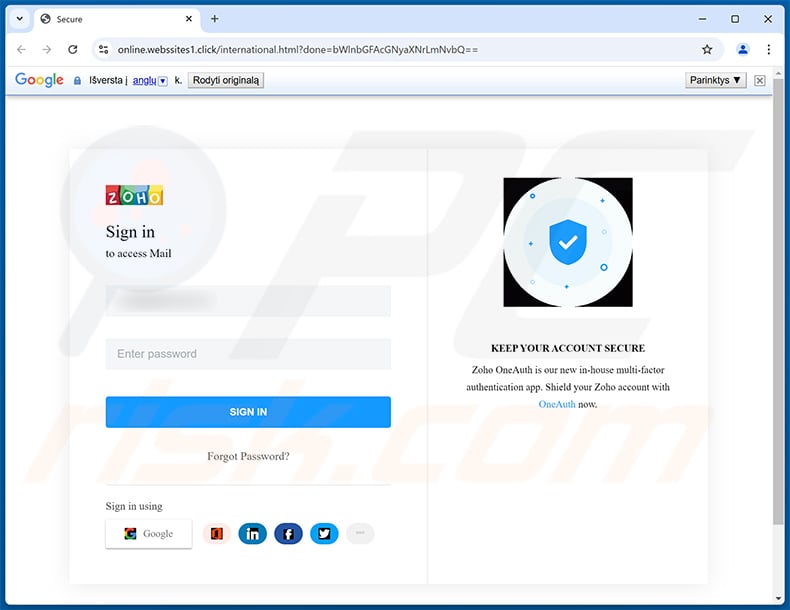
Sample 3:
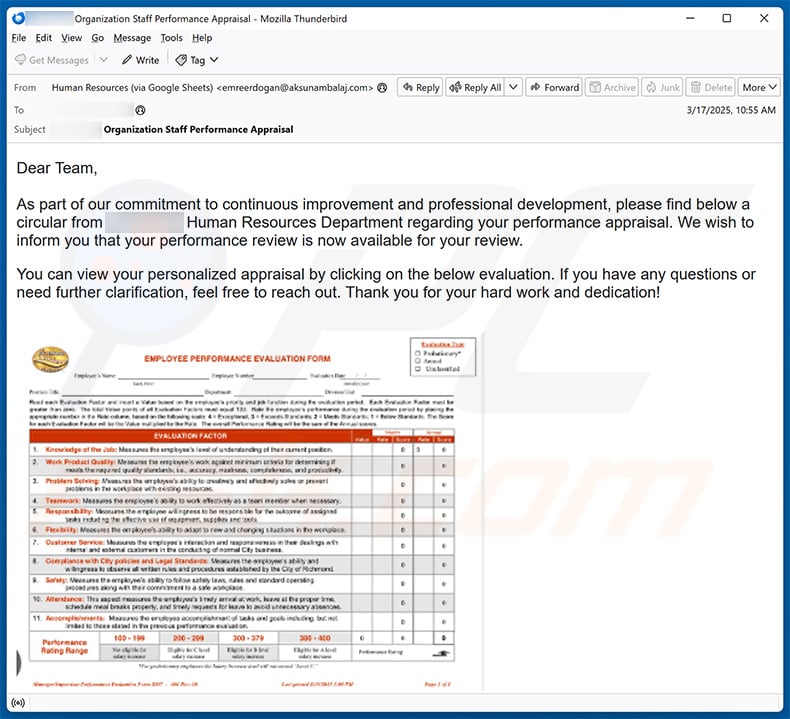
Text presented within:
Subject: ******** Organization Staff Performance Appraisal
Dear Team,
As part of our commitment to continuous improvement and professional development, please find below a circular from ******** Human Resources Department regarding your performance appraisal. We wish to inform you that your performance review is now available for your review.
You can view your personalized appraisal by clicking on the below evaluation. If you have any questions or need further clarification, feel free to reach out. Thank you for your hard work and dedication!
We appreciate your continued service and commitment to our organization.
Best Regards
Director
********
Human Resources and Communication Department
Screenshot of the promoted phishing site:
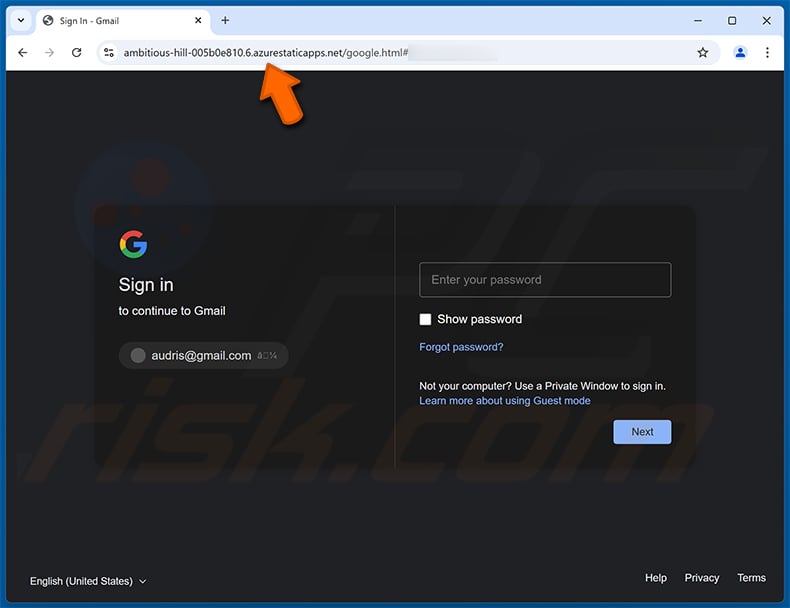
Instant automatic malware removal:
Manual threat removal might be a lengthy and complicated process that requires advanced IT skills. Combo Cleaner is a professional automatic malware removal tool that is recommended to get rid of malware. Download it by clicking the button below:
DOWNLOAD Combo CleanerBy downloading any software listed on this website you agree to our Privacy Policy and Terms of Use. To use full-featured product, you have to purchase a license for Combo Cleaner. 7 days free trial available. Combo Cleaner is owned and operated by RCS LT, the parent company of PCRisk.com.
Quick menu:
- What is "Employees Performance Report" phishing email?
- Types of malicious emails.
- How to spot a malicious email?
- What to do if you fell for an email scam?
Types of malicious emails:
![]() Phishing Emails
Phishing Emails
Most commonly, cybercriminals use deceptive emails to trick Internet users into giving away their sensitive private information, for example, login information for various online services, email accounts, or online banking information.
Such attacks are called phishing. In a phishing attack, cybercriminals usually send an email message with some popular service logo (for example, Microsoft, DHL, Amazon, Netflix), create urgency (wrong shipping address, expired password, etc.), and place a link which they hope their potential victims will click on.
After clicking the link presented in such email message, victims are redirected to a fake website that looks identical or extremely similar to the original one. Victims are then asked to enter their password, credit card details, or some other information that gets stolen by cybercriminals.
![]() Emails with Malicious Attachments
Emails with Malicious Attachments
Another popular attack vector is email spam with malicious attachments that infect users' computers with malware. Malicious attachments usually carry trojans that are capable of stealing passwords, banking information, and other sensitive information.
In such attacks, cybercriminals' main goal is to trick their potential victims into opening an infected email attachment. To achieve this goal, email messages usually talk about recently received invoices, faxes, or voice messages.
If a potential victim falls for the lure and opens the attachment, their computers get infected, and cybercriminals can collect a lot of sensitive information.
While it's a more complicated method to steal personal information (spam filters and antivirus programs usually detect such attempts), if successful, cybercriminals can get a much wider array of data and can collect information for a long period of time.
![]() Sextortion Emails
Sextortion Emails
This is a type of phishing. In this case, users receive an email claiming that a cybercriminal could access the webcam of the potential victim and has a video recording of one's masturbation.
To get rid of the video, victims are asked to pay a ransom (usually using Bitcoin or another cryptocurrency). Nevertheless, all of these claims are false - users who receive such emails should ignore and delete them.
How to spot a malicious email?
While cyber criminals try to make their lure emails look trustworthy, here are some things that you should look for when trying to spot a phishing email:
- Check the sender's ("from") email address: Hover your mouse over the "from" address and check if it's legitimate. For example, if you received an email from Microsoft, be sure to check if the email address is @microsoft.com and not something suspicious like @m1crosoft.com, @microsfot.com, @account-security-noreply.com, etc.
- Check for generic greetings: If the greeting in the email is "Dear user", "Dear @youremail.com", "Dear valued customer", this should raise suspiciousness. Most commonly, companies call you by your name. Lack of this information could signal a phishing attempt.
- Check the links in the email: Hover your mouse over the link presented in the email, if the link that appears seems suspicious, don't click it. For example, if you received an email from Microsoft and the link in the email shows that it will go to firebasestorage.googleapis.com/v0... you shouldn't trust it. It's best not to click any links in the emails but to visit the company website that sent you the email in the first place.
- Don't blindly trust email attachments: Most commonly, legitimate companies will ask you to log in to their website and to view any documents there; if you received an email with an attachment, it's a good idea to scan it with an antivirus application. Infected email attachments are a common attack vector used by cybercriminals.
To minimise the risk of opening phishing and malicious emails we recommend using Combo Cleaner Antivirus for Windows.
Example of a spam email:

What to do if you fell for an email scam?
- If you clicked on a link in a phishing email and entered your password - be sure to change your password as soon as possible. Usually, cybercriminals collect stolen credentials and then sell them to other groups that use them for malicious purposes. If you change your password in a timely manner, there's a chance that criminals won't have enough time to do any damage.
- If you entered your credit card information - contact your bank as soon as possible and explain the situation. There's a good chance that you will need to cancel your compromised credit card and get a new one.
- If you see any signs of identity theft - you should immediately contact the Federal Trade Commission. This institution will collect information about your situation and create a personal recovery plan.
- If you opened a malicious attachment - your computer is probably infected, you should scan it with a reputable antivirus application. For this purpose, we recommend using Combo Cleaner Antivirus for Windows.
- Help other Internet users - report phishing emails to Anti-Phishing Working Group, FBI’s Internet Crime Complaint Center, National Fraud Information Center and U.S. Department of Justice.
Frequently Asked Questions (FAQ)
Why did I receive this email?
Regardless of any relevant details that they may include, spam emails are not personal. This mail is sent out in massive operations – hence, thousands of users receive identical messages.
I have provided my personal information when tricked by this spam email, what should I do?
If you have provided your log-in credentials – change the passwords of all possibly exposed accounts and inform their official support. However, if you've disclosed other private information (e.g., ID card details, credit card numbers, etc.) – contact the appropriate authorities.
I have read a spam email but didn't open the attachment, is my computer infected?
No, just reading an email is harmless. Systems are infected when malicious attachments or links are opened.
I have downloaded and opened a file attached to a spam email, is my computer infected?
If the opened file was an executable (.exe, .run, etc.) – most likely, yes – your device was infected. However, you might have avoided this if it was a document (.doc, .xls, .pdf, .one, etc.). Said formats may need extra actions to jumpstart malware download/installation chains (e.g., enabling macro commands, clicking embedded content, etc.).
Will Combo Cleaner remove malware infections present in email attachments?
Yes, Combo Cleaner is designed to detect and remove all manner of threats. It is capable of eliminating practically all known malware infections. It must be stressed that performing a full system scan is essential since sophisticated malicious programs usually hide deep within systems.
Share:

Tomas Meskauskas
Expert security researcher, professional malware analyst
I am passionate about computer security and technology. I have an experience of over 10 years working in various companies related to computer technical issue solving and Internet security. I have been working as an author and editor for pcrisk.com since 2010. Follow me on Twitter and LinkedIn to stay informed about the latest online security threats.
PCrisk security portal is brought by a company RCS LT.
Joined forces of security researchers help educate computer users about the latest online security threats. More information about the company RCS LT.
Our malware removal guides are free. However, if you want to support us you can send us a donation.
DonatePCrisk security portal is brought by a company RCS LT.
Joined forces of security researchers help educate computer users about the latest online security threats. More information about the company RCS LT.
Our malware removal guides are free. However, if you want to support us you can send us a donation.
Donate
▼ Show Discussion